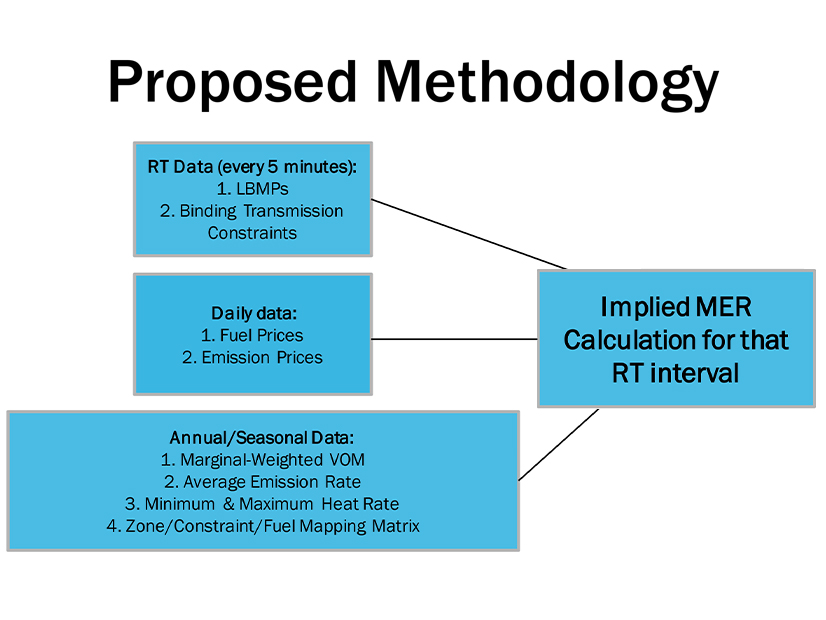NYISO on Monday presented the Installed Capacity Working Group/Market Issues Working Group (ICAP/MIWG) with proposed methodology for measuring implied marginal emission rates (IMERs) to increase transparency around New York’s emissions output by providing real-time data.
The ISO chose the IMER “heat rate” methodology to measure emissions production over other options because, staff said, it is highly variable and granular, performs well in grids with clearly defined marginal fuel types, and helps identify persistent congestion patterns.
The methodology uses LMPs, fuel prices, emissions costs, and variable operation and maintenance costs as inputs to estimate the implied heat rate, which is then used to estimate the real-time zonal IMER in tons of carbon per megawatt-hour for a given implied marginal fuel.
Stakeholders requested NYISO publish real time marginal and average zonal emissions rates data to help them comply with state energy and climate legislation, particularly Local Law 97, which set strict carbon reduction standards for large New York City buildings. (See NYC Proposes Rules to Implement Building Emissions Law.)
Aaron Breidenbaugh, director of regulatory affairs at CPower Energy Management, asked why stakeholders had requested this project, to which William Acker, executive director of the New York Battery and Energy Storage Technology Consortium, responded that his organization, along with state agencies and other stakeholders, need this information to support LL97 compliance.
“We need to have at least hourly marginal numbers available for the accounting under [LL97], and secondly, it’s valuable to have something that is forward looking and that isn’t simply scorekeeping but is actually actionable by people managing buildings in New York City,” Acker said.
NYISO will return to the ICAP/MIWG either next month or in June to share additional information on the methodology’s inputs and is targeting the fourth quarter to deliver the functional requirement specifications.
Renewable Regulation Requirements
NYISO also presented the ICAP/MIWG with proposed revisions to the regulation requirements for renewable resources in the state.
As New York installs more wind and solar projects, the ISO has been required to regularly update its regulation requirements, starting in 2010 and again in 2016, to ensure that these resources are not negatively impacting its ability to balance the bulk power system or disrupting voltage requirements.
NYISO modeled two scenarios that predict the total amount of installed nameplate capacities of land-based wind (LBW), offshore wind (OSW) and solar at the end of a given year: Scenario 1 projects that 3,000 MW of LBW, 125 MW of OSW and 7,651 MW of solar will be installed by 2024; while Scenario 2 projects 3,700 MW, 125 MW and 9,768 MW, respectively, will be installed by 2026.
NYISO is proposing that Scenario 1’s set of new regulation requirements be implemented on June 1, and that Scenario 2 be implemented in 2025. The ISO would send stakeholders market notices in case capacity levels approach those in the scenarios earlier than projected.
NYISO will seek approval for its proposed scenarios and their implementation timelines at the Operating Committee’s meeting Thursday.



